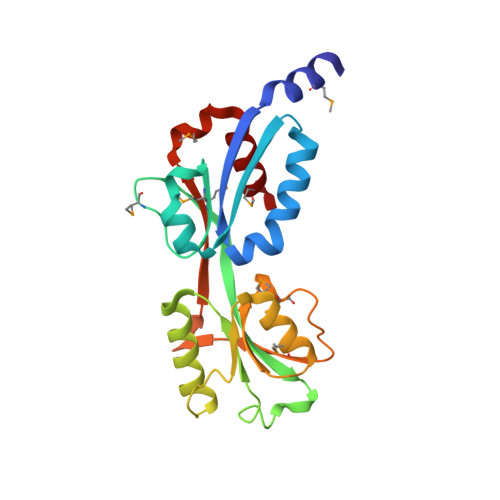Metabolic sensor governing bacterial virulence in Staphylococcus aureus.
Ding, Y., Liu, X., Chen, F., Di, H., Xu, B., Zhou, L., Deng, X., Wu, M., Yang, C.G., Lan, L.(2014) Proc Natl Acad Sci U S A 111: E4981-E4990
- PubMed: 25368190
- DOI: https://doi.org/10.1073/pnas.1411077111
- Primary Citation of Related Structures:
4QBA - PubMed Abstract:
An effective metabolism is essential to all living organisms, including the important human pathogen Staphylococcus aureus. To establish successful infection, S. aureus must scavenge nutrients and coordinate its metabolism for proliferation. Meanwhile, it also must produce an array of virulence factors to interfere with host defenses. However, the ways in which S. aureus ties its metabolic state to its virulence regulation remain largely unknown. Here we show that citrate, the first intermediate of the tricarboxylic acid (TCA) cycle, binds to and activates the catabolite control protein E (CcpE) of S. aureus. Using structural and site-directed mutagenesis studies, we demonstrate that two arginine residues (Arg145 and Arg256) within the putative inducer-binding cavity of CcpE are important for its allosteric activation by citrate. Microarray analysis reveals that CcpE tunes the expression of 126 genes that comprise about 4.7% of the S. aureus genome. Intriguingly, although CcpE is a major positive regulator of the TCA-cycle activity, its regulon consists predominantly of genes involved in the pathogenesis of S. aureus. Moreover, inactivation of CcpE results in increased staphyloxanthin production, improved ability to acquire iron, increased resistance to whole-blood-mediated killing, and enhanced bacterial virulence in a mouse model of systemic infection. This study reveals CcpE as an important metabolic sensor that allows S. aureus to sense and adjust its metabolic state and subsequently to coordinate the expression of virulence factors and bacterial virulence.
Organizational Affiliation:
Department of Molecular Pharmacology and.
















